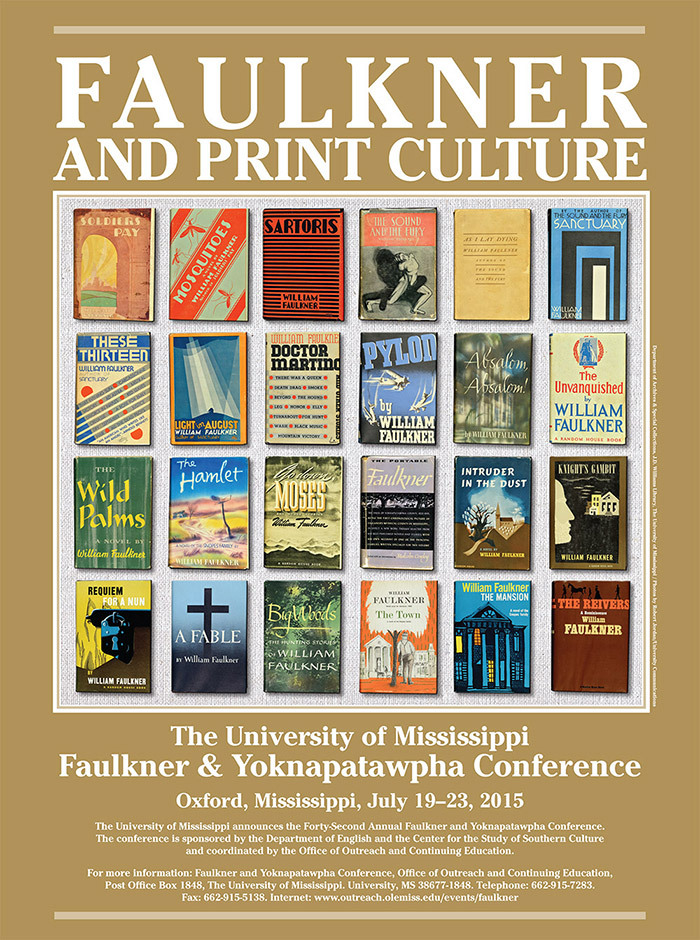
Panel. Pulp Faulkner
Location
Nutt Auditorium
Start Date
21-7-2015 3:30 PM
Description
- An Error in Canonicity, or, A Fuller Story of Faulkner's Return to Print Culture, 1944-1951 / John N. Duvall, Purdue University
The postwar recuperation of Faulkner within print culture occurs on two fronts, culminating in Faulkner’s receiving the Nobel Prize for literature in 1950. The first front is a story we know well: the construction of literary (or high) Faulkner created by Malcolm Cowley’s Portable Faulkner (1946) and the publication in 1950 of Collected Stories of William Faulkner. The second largely overlooked front we might call pulp Faulkner, the writer of crime and detective fiction published in mass-market paperbacks and magazines. Focusing on this second front, my paper looks closely at a different editor who championed Faulkner from 1944 to 1951—Frederic Danny, who edited Ellery Queen’s Mystery Magazine—in order to argue that Faulkner scholars have perhaps been too quick share Faulkner’s distain for winning second-prize in the first Ellery Queen detective story contest. In a number of ways, the first Faulkner novels to come back into print between 1947 and 1951 owe more to the mass-culture world of Dannay and Ellery Queen than to the high-culture world of Malcolm Cowley. - On Faulkner's B-Sides: Balance, Bonus, Bastard / Robert Jackson, University of Tulsa
My paper interrogates an underappreciated pattern in Faulkner’s career: his turn to the popular at moments when his work on the more experimental “modernist” works was coming slowly, not generating substantial income, or both, and the relationships these works have with one another in composition, publication, and reception. In addition to short stories and screen writings, key examples include Sanctuary’s contextualization with The Sound and the Fury; Pylon in the context of, and as a respite to, Absalom, Absalom!; and the case study I will discuss in detail here, Intruder in the Dust in the context of A Fable, a novel that consumed Faulkner’s attention for more than a decade. - Trashing Sanctuary / Kristin Fujie, Lewis and Clark College
This paper attempts to think across the divide between high art and low pulp in Faulkner’s work by exploring the textual process that produced his greatest commercial success, Sanctuary. I propose that when Faulkner rewrote Sanctuary in order to make of it “something which would not shame The Sound and the Fury and As I Lay Dying,” he did so by trashing it--cutting it up and touting its pulpish roots so as to sever the novel’s connections to the creative matrix that had produced his previous two novels. By recovering some of these connections, I explore how Sanctuary tapped into this matrix in radical ways, and how Faulkner’s trashing of the novel served to contain and defer volatile material that resurfaces at the heart of his subsequent work.
Relational Format
Conference proceeding
Recommended Citation
Duvall, John N.; Jackson, Robert; and Fujie, Kristin, "Panel. Pulp Faulkner" (2015). Faulkner and Yoknapatawpha Conference. 18.
https://egrove.olemiss.edu/fy/2015/schedule/18
COinS
Jul 21st, 3:30 PM
Panel. Pulp Faulkner
Nutt Auditorium
- An Error in Canonicity, or, A Fuller Story of Faulkner's Return to Print Culture, 1944-1951 / John N. Duvall, Purdue University
The postwar recuperation of Faulkner within print culture occurs on two fronts, culminating in Faulkner’s receiving the Nobel Prize for literature in 1950. The first front is a story we know well: the construction of literary (or high) Faulkner created by Malcolm Cowley’s Portable Faulkner (1946) and the publication in 1950 of Collected Stories of William Faulkner. The second largely overlooked front we might call pulp Faulkner, the writer of crime and detective fiction published in mass-market paperbacks and magazines. Focusing on this second front, my paper looks closely at a different editor who championed Faulkner from 1944 to 1951—Frederic Danny, who edited Ellery Queen’s Mystery Magazine—in order to argue that Faulkner scholars have perhaps been too quick share Faulkner’s distain for winning second-prize in the first Ellery Queen detective story contest. In a number of ways, the first Faulkner novels to come back into print between 1947 and 1951 owe more to the mass-culture world of Dannay and Ellery Queen than to the high-culture world of Malcolm Cowley. - On Faulkner's B-Sides: Balance, Bonus, Bastard / Robert Jackson, University of Tulsa
My paper interrogates an underappreciated pattern in Faulkner’s career: his turn to the popular at moments when his work on the more experimental “modernist” works was coming slowly, not generating substantial income, or both, and the relationships these works have with one another in composition, publication, and reception. In addition to short stories and screen writings, key examples include Sanctuary’s contextualization with The Sound and the Fury; Pylon in the context of, and as a respite to, Absalom, Absalom!; and the case study I will discuss in detail here, Intruder in the Dust in the context of A Fable, a novel that consumed Faulkner’s attention for more than a decade. - Trashing Sanctuary / Kristin Fujie, Lewis and Clark College
This paper attempts to think across the divide between high art and low pulp in Faulkner’s work by exploring the textual process that produced his greatest commercial success, Sanctuary. I propose that when Faulkner rewrote Sanctuary in order to make of it “something which would not shame The Sound and the Fury and As I Lay Dying,” he did so by trashing it--cutting it up and touting its pulpish roots so as to sever the novel’s connections to the creative matrix that had produced his previous two novels. By recovering some of these connections, I explore how Sanctuary tapped into this matrix in radical ways, and how Faulkner’s trashing of the novel served to contain and defer volatile material that resurfaces at the heart of his subsequent work.

